38 Types of Acorns (With Pictures) – Identification Guide For Oaks By Acorns
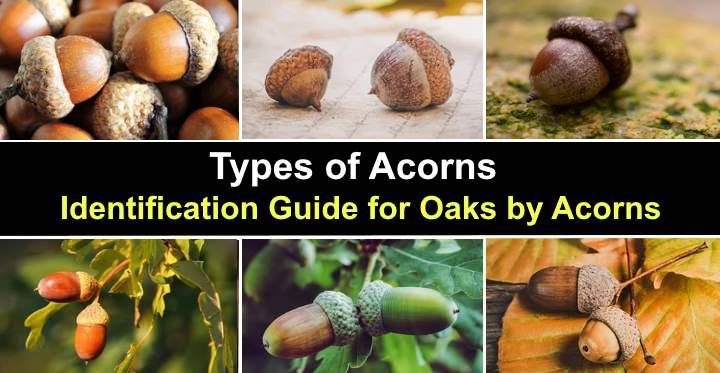
An acorn or oaknut is the nut of the oak trees. Each acorn contains one or two oak seeds and it is enclosed in a tough protective shell. Acorns have a distinctive oval shape with a scaly or warty cap called a cupule. The edible acorns usually take between 6 to 24 months to mature.
Usually, it’s possible to identify a species of oak tree by observing the characteristics of acorns. For example, some acorns are round with a blunt tip, whereas others are oblong and pointed. Acorns vary in color from typical brown to shades of green, chestnut red, reddish-brown, and black.
This article is a guide to identifying acorns by observing their color, shape, type of cupule, and size. This helpful information will also help identify different species of oak trees in a landscape.
What is an Acorn?
Acorn is the fruit from an oak tree. Each acorn or oaknut contains one or two large seeds enclosed in a tough protective shell that sits in a cup-shaped cap. The edible acorn nut usually takes six to 24 months to mature, and a plentiful acorn harvest usually occurs every four years or so.
How to Identify Acorns
Each species of oak tree produces distinctive acorns. The identifying characteristics of an acorn are its cup, shape, color, and size. The acorn’s woody cup may be scaly, smooth, or hairy. Acorns are usually ball-shaped or oval, and some kinds have slight ridges on them. Mature acorns can be brown, red, or black.
Here is how to identify the type of oak tree acorn:
1. Identify acorn by its cup scales
To tell the type of acorn, look at the hat-like woody cup. Native North American acorns have cups with overlapping scales. Then look at how much of the cupule covers the nut. Some acorn cups can cover up to half of the nut’s length. Other types of acorns have shallow, thin caps.
2. Identify acorn by its shape
Species of oaks produce acorns with distinctive shapes and sizes. Typically, acorns fall into two categories—round or oblong. Looking closely, you may notice delicate parallel ridges running up to the tip. Additionally, some acorns have pointed tips, but others have smooth rounded tops.
3. Identify acorn by its color
It’s possible to tell the oak species by the color of a mature acorn. Oak nuts mature to colors such as light brown, dark brown, reddish-brown, purplish-red, or even black. If you find green acorns on the ground, this is usually because they have fallen from the oak before maturing.
4. Identify acorn by its size
Acorns range in size, which helps identify the oak tree species. Some tiny acorn nuts are around 0.5” (12 mm). The largest acorns are from the bur oak and they can be 2” to 3” (50 – 75 mm) in diameter.
You can also look at the cup’s size. The cups of some types of acorns almost cover the entire nut, whereas others barely cover the base.
5. Identify acorn by its hairs
The presence of hairs on the acorn cup is another identifying feature. The most common oak species produce acorns with scaly cupules that are tough and woody. Other types of acorns have wooly cups with long matted hairs. Then there are some acorn varieties with smooth cups without a bumpy texture.
Are Acorns Edible?
Acorns are edible nuts that can be roasted, ground into flour, or used for a caffeine-free coffee-like drink. However, raw acorns contain bitter tasting tannin that may be toxic to humans. Before consuming acorns, it’s vital to leach acorns to remove their tannin to improve their taste and make them suitable for human consumption. To leach the tannin and make acorns edible, soak the acorns in water and drain them. Then repeat the process until the water runs clear.
The Different Types of Acorns (Sweetest, Largest, Fattiest, Smallest)
If you want to eat delicious acorns, it’s vital to identify the sweetest variety of nuts. The acorn harvest is from September until early spring. It would be best to look for mature acorns without any holes in the thick leathery shells.
Sweetest acorns: Sweet acorns have the lowest levels of tannins and are the easiest to prepare. Types of oaks with sweet acorns include pin oak, burr oak, east coast white oak, and cork oak.
Largest acorns: Large acorns generally have a hairy cupule. Oak trees producing the largest acorns are the east coast white oak, burr oak, and the California black oak.
Fattiest acorns: If you want to make acorn oil, choose acorns from the eastern red oak or black oak. These nuts tend to have the highest oil content from all types of acorns.
Smallest acorns: Small acorns tend to be rounded and flattened and not useful for consumption. The smallest acorns come from the chinquapin oak and cherry bark oak.
White Oak Acorns Vs. Red Oak Acorns
Native oak trees in North America generally fall into two categories—white oaks and red oaks. The main difference between white oak acorns and red oak acorns is their shape. Acorns from white oaks tend to be longer and oval, whereas acorns from red oaks are rounded and flatter.
Types of Acorns (With Pictures) – Identification Guide
Let’s look in detail at how to identify types of common acorns you are likely to find in woodlands, parks, and deciduous forests.
White Oak Acorn (Quercus alba)
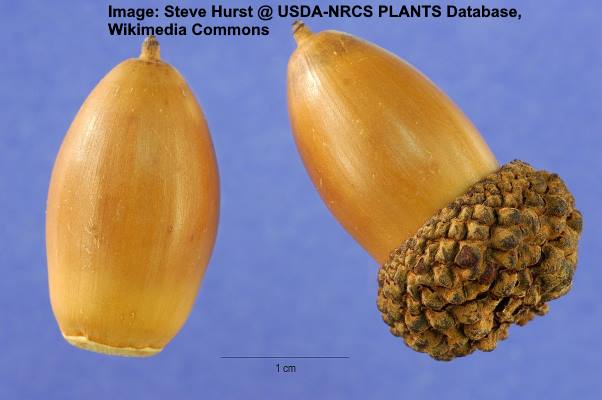
White Oak Acorns (Quercus alba)
Acorns from white oaks are glossy, light brown nuts with an ovoid or oblong shape. The nuts have a rounded end with a pointed tip. The scaly woody cup-shaped caps cover about one-fourth of the nut and grow from 0.75” to 1” (20 – 25 mm). White oak acorns mature on the tree in one season.
Oak tree identification: The white oak tree has the acorn most people associate with oak trees. The tree also has recognizable leaves with deep finger-like round lobes. The leaves grow up to 9” (23 cm) long and turn deep red in the fall. White oaks grow 80 – 100 ft. (24 – 30 m) tall.
Further reading: White Oak Tree – Identification Guide.
Northern Red Oak Acorn (Quercus rubra)
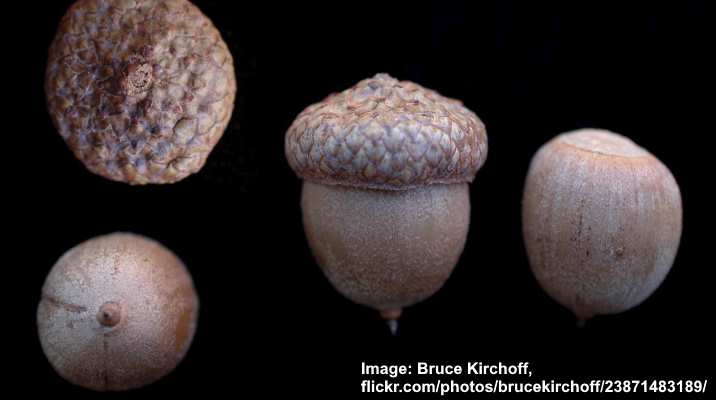
Northern Red Oak Acorns (Quercus rubra)
Acorns from the northern red oak are stout, barrel-shaped brown nuts that grow 0.75” to 1” (20 – 25 mm) long. The brown oak nuts have an identifiable rounded, wide cupule covering about one-quarter of the nut. Like all red oak species, the acorns mature on the trees for two years.
Oak tree identification: The northern red oak tree acorns are brown and stumpy. The tree has lobed leaves with pointed tips. Additionally, the red oak bark has deep furrows, scaly ridges, and an appearance of shiny stripes.
Southern Red Oak Acorn (Quercus falcata)
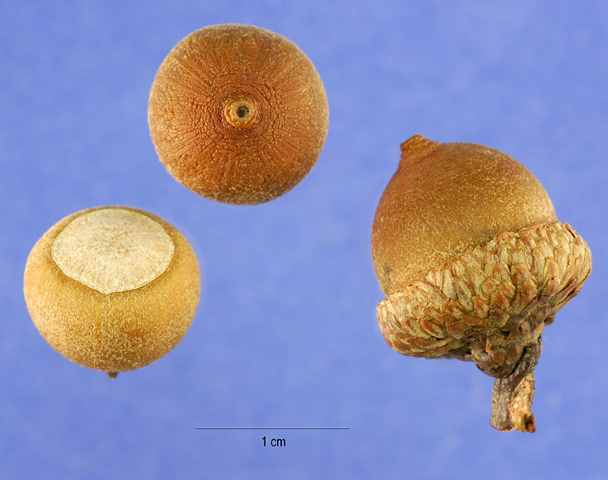
Southern Red Oak Acorns (Quercus falcata)
Acorns from the southern red oak are small, dome-shaped nuts with a light tan or orange-brown color. The acorns have recognizable flat, woody caps covering about one-third of the hard nut. The small acorns grow 0.35” to 0.6” (9 – 16 mm) long.
Oak tree identification: The southern red oak tree is identified by its ovate leaves with irregular lobes and bristle tips. The tree also has pear-shaped leaves with three rounded lobes.
English Oak Acorn (Quercus robur)
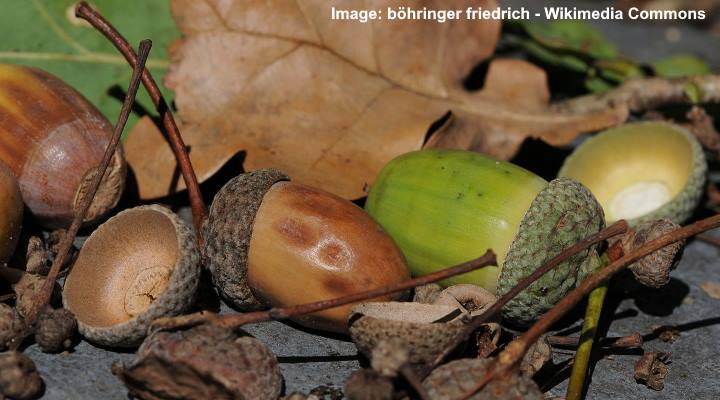
English Oak Acorn (Quercus robur)
Acorns from the English oak tree are shiny brown egg-shaped nuts that grow up to 1” (25 mm) long. The cup-shaped caps cover about one-third of the brown acorn and have a tough, warty texture. The acorns drop from the cupules when they mature in the fall. English oak acorns grow in clusters of one to four nuts.
Oak tree identification: The English oak tree has oval brown acorns sitting in thin tan caps. The oak tree is identified by its obovate leaves with three to seven pairs of blunt lobes along the margins.
Southern Live Oak Acorn (Quercus virginiana)
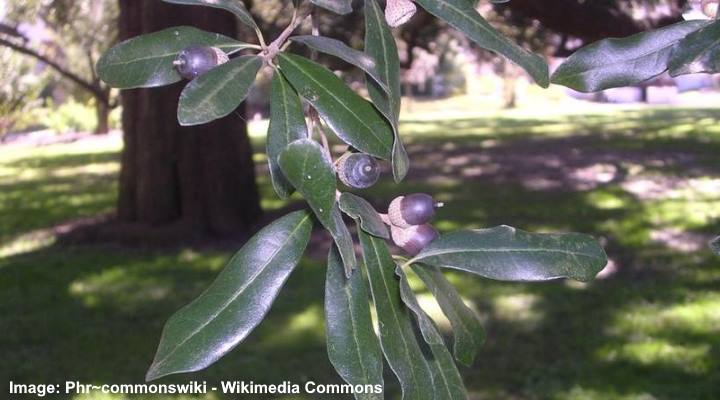
Southern Live Oak Acorns (Quercus virginiana)
Acorns growing on the southern live oak are small ovoid nuts that mature to a distinctive black color. The rounded black nuts with pointed tips sit in tan-colored warty caps covering about one-third of the fruit. The egg-shaped acorns measure 0.75” – 1” (20 – 25 mm) and grow in clusters up to five.
Oak tree identification: The characteristic features of the evergreen southern live oak tree are the black acorns and its glossy green oblong leaves without the distinctive lobes of typical oak trees.
Further reading: Live Oak Tree – Identification and Growing Guide.
Scarlet Oak Acorn (Quercus coccinea)

Scarlet Oak Acorns (Quercus coccinea)
Acorns from the scarlet oak tree are small, light brown nuts that sit in a deep woody cup. The bitter brown acorns have a stout appearance with a rounded tip. The oversized brown cupules are thick and woody and cover up to one-half of the acorn’s length. The acorns measure 0.5 – 1” (13 – 25 mm) long.
Oak tree identification: The scarlet oak tree is identified by its small brown acorns and ovate leaves with thin, finger-like pointed lobes. In the fall, scarlet oaks turn a spectacular deep red color.
Black Oak Acorn (Quercus velutina)
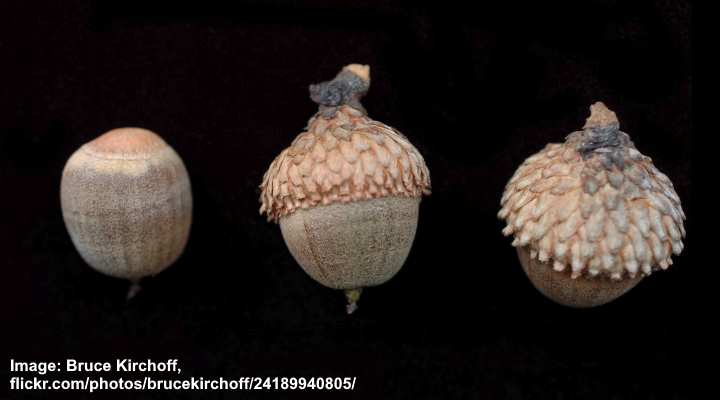
Black Oak Acorns (Quercus velutina)
Acorns from the black oak tree have a broadly rounded shape and light brown or tan color. Black oak acorns have a distinctive cup with relatively loose scales that create a fringe. The acorns measure 0.5” to 1” (13 – 25 mm) long, and the fat cup covers half of the nut.
Oak tree identification: The black oak tree has recognizable light-colored acorns and glossy green, ovate leaves with rounded, bristle-tipped lobes. The leathery green leaves turn yellow or brownish-red in the fall.
Chinkapin Oak Acorn (Quercus muehlenbergii)

Chinkapin Oak Acorns (Quercus muehlenbergii)
The chinkapin oak produces small acorns that grow on short stalks and mature to a dark brown or black color. The chinkapin acorns have an ovoid shape and are dark brown to black sitting in a pale gray cupule. Chinkapin acorns have distinctive creamy white flesh that is deliciously sweet. The acorns measure 0.75” (20 mm) long.
Also called chinquapin acorns, the nuts are described as some of the sweetest acorns you can find.
Oak tree identification: Also called chinquapin oaks, this native deciduous tree has distinctive black acorns and oblong leaves with toothed margins that have a wavy appearance.
Willow Oak Acorn (Quercus phellos)
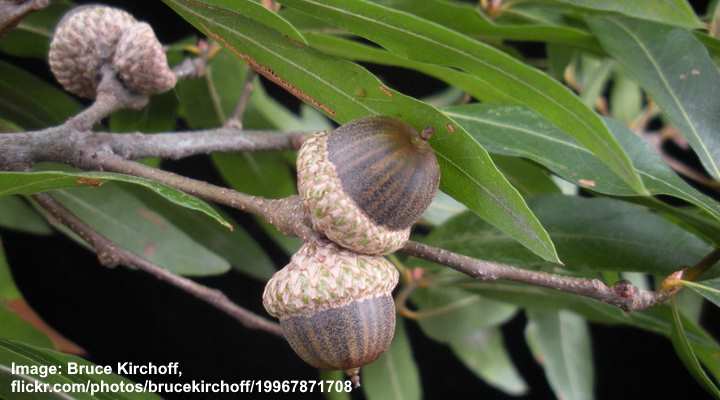
Willow Oak Acorns (Quercus phellos)
Acorns from the willow oak are small, rounded nuts with a dark brown, almost black appearance. Pictures of the acorns show pale vertical ridges on the thick leathery shell. The dark-colored acorns sit in a scaly tan-colored cap. Willow oak acorns measure around 0.5” (13 mm) long and almost as wide.
A fact about willow oak trees is that they produce copious amounts of acorns.
Oak tree identification: The willow oak tree has small dark-colored acorns and unique leaves. Unlike other oak tree species, the willow oak leaves are thin and pointed like willow tree leaves.
Shumard Oak Acorn (Quercus shumardii)
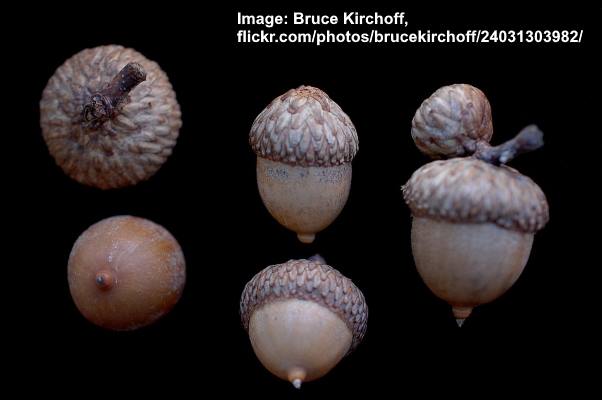
Shumard Oak Acorns (Quercus shumardii)
Acorns from the Shumard oak tree are egg-shaped nuts with a scaly cap. The dark brown acorns grow on short stems and measure 1.25” (32 mm) long and 1” (25 mm) wide. The oblong brown acorns sit in caps covering one-third of the nut, and are enjoyed by wildlife.
Oak tree identification: The Shumard oak has brown acorns and broad leaves with 5–11 lobes with bristled tips. The curve between lobes varies widely among trees, ranging from shallow to almost halfway through the lobe, making the glossy green leaves look like holly leaves.
Pin Oak Acorn (Quercus palustris)
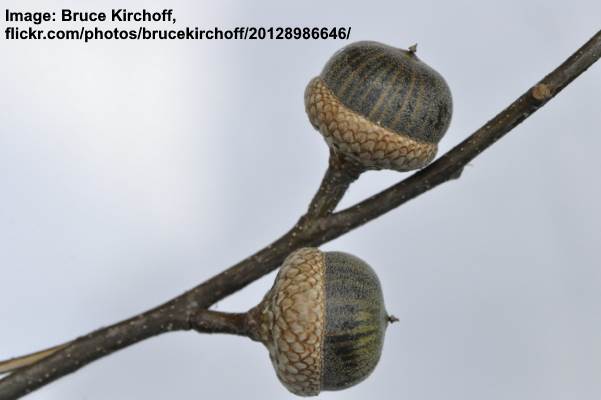
Pin Oak Acorns (Quercus palustris)
Acorns from the pin oak tree are black acorns rounded in shape with a reasonably flat top. The small dark acorns measure up to 0.5” (13 mm) long and sit on a thin tan, scaly cap that covers one-third of the nut. Pin oak acorns grow singularly or in clusters of two or three.
Oak tree identification: Pin oak trees have recognizable black acorns with a distinct round shape. The pin oak leaves are unevenly shaped, usually with five to seven pointed lobes. Another identifying feature is the pale orange-brown tuft of downy hairs on the leaf undersides.
Bur Oak Acorn (Quercus macrocarpa)
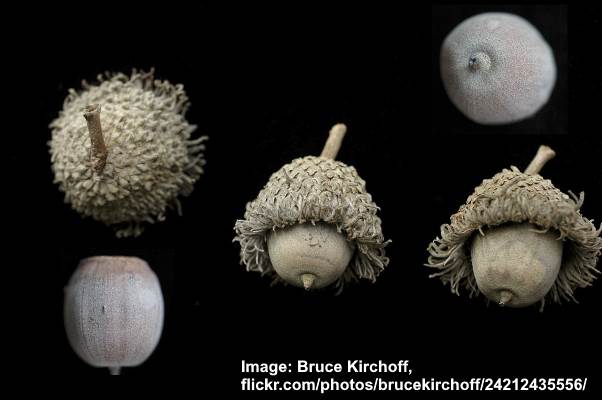
Bur Oak Acorns (Quercus macrocarpa)
The bur oak tree produces the largest acorns of any oak tree. Bur oak acorns are globose grayish-brown nuts with large, hairy cups that almost cover the entire nut. Bur oak acorns measure up to 1.5” (38 mm) long and wide.
Oak tree identification: The identifying feature of the bur oak tree is grayish-brown acorns and fringed cups. The oak tree also has large, leathery leaves with five to nine round-tipped lobes. The lower lobes tend to be smaller than the upper ones.
California Black Oak Acorn (Quercus kelloggii)
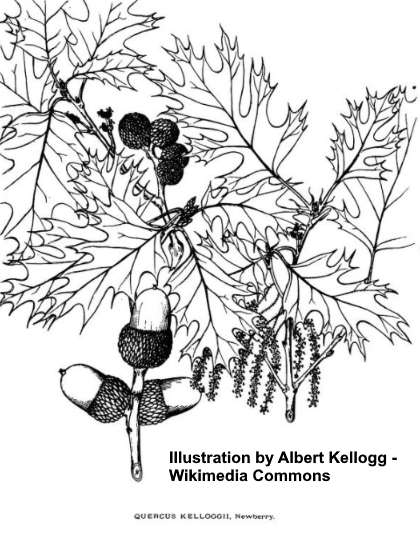
Illustration of California Black Oak Acorns (Quercus kelloggii)
The acorns on the California black oak tree are large egg-shaped nuts that taper to a pointed tip. The acorns mature to a rich mahogany brown color and have light brown scaly caps and fringes that reach about halfway up the shiny nuts. California black oak nuts measure 1.2” (30 mm) long and 0.7” (18 mm) wide.
Oak tree identification: The California black oak tree has dark brown egg-shaped acorns and glossy green leaves with seven to 11 deep, bristle-tipped lobes. Leaves measure between 3.1” 6” (80 – 150 mm) long with the widest point in the middle.
Coast Live Oak Acorn (Quercus agrifolia)
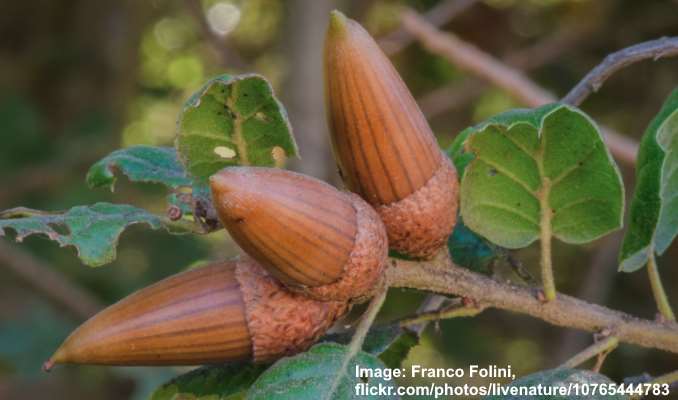
Coast Live Oak Acorns (Quercus agrifolia)
Acorns from the coast live oak tree are conical shaped, dark brown acorns with the broadest part sitting in orangey-brown relatively smooth cups. The reddish-brown acorns measure up to 1.4” (35 mm) long and 0.6” (15 mm) wide. The cup covers about one-quarter of the fruit.
Unlike other types of red oaks, coast live acorns mature in eight months rather than the typical 18 months.
Oak tree identification: The coast live oak tree is identified by its conical acorns and oval-shaped leaves with spiny-toothed margins.
Post Oak Acorns (Quercus stellata)
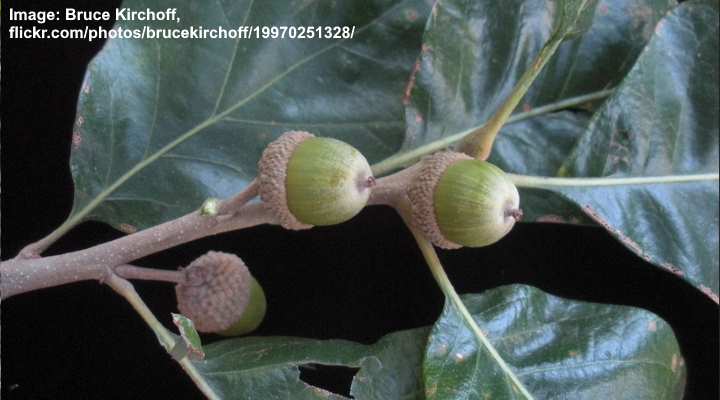
Post Oak Immature Acorns (Quercus stellata)
Acorns growing on the post oak tree are brown, egg-shaped nuts growing solitary or in pairs on oak trees. Post oak acorns have warty caps that are light gray to tan in color. The reddish-brown acorns grow 0.5” to 1” (13 – 25 mm), and the caps cover one-third of the acorn.
Oak tree identification: The post oak tree has characteristic brown acorns sitting in a tan-colored cap. The oak leaves have a distinctive shape due to the three large terminal lobes creating the form of a cross. Leaves measure up to 8” (240 mm) long.
Blue Oak Acorn (Quercus douglasii)
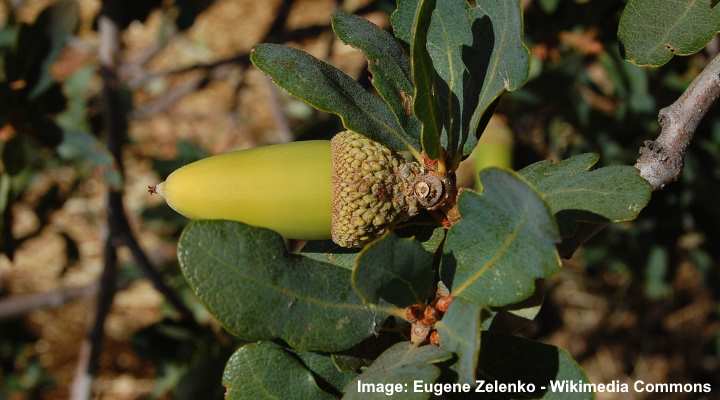
Blue Oak Immature Acorn (Quercus douglasii)
Acorns from the blue oak tree have a distinct egg shape that tapers to a narrow point. The conical acorns mature from green to a dark brown, almost black. These sweet brown acorns grow 0.8” to 1.2” (20 – 30 mm) long, and the cupule is 0.2” (15 mm in diameter).
Oak tree identification: The blue oak tree has large pointed brown acorns sitting in thin scaly cups. The oak tree leaves have shallow lobes with rounded tips and measure up to 4” (100 cm) long.
Bluff Oak Acorn (Quercus austrina)
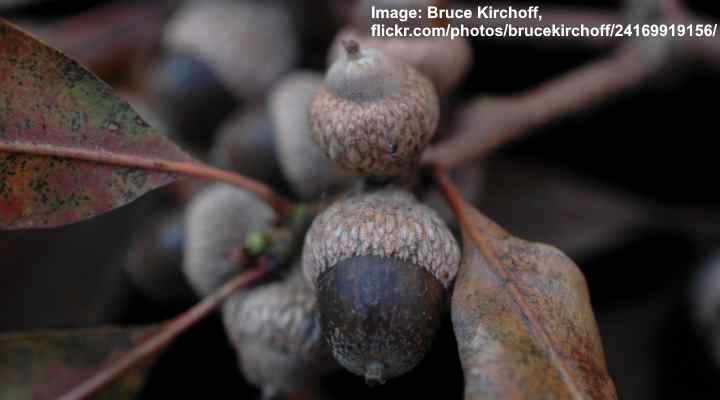
Bluff Oak Acorns (Quercus austrina)
The bluff oak acorn is a distinctive oval nut that turns from green to a dark brown, almost black color. The brownish-black acorns sit in a scaly gray-silver cupule. Bluff oak acorns grow between 0.5” and 1” (13 – 25 mm) and develop singularly or in pairs on bluff oak trees.
Oak tree identification: The bluff oak tree is identified by its smooth, dark brown acorns with a contrasting gray scaly cap. The oak tree has showy green leaves with rounded, irregular lobes that turn a distinctive orange, yellow, or copper color in the fall.
Swamp White Oak Acorn (Quercus bicolor)
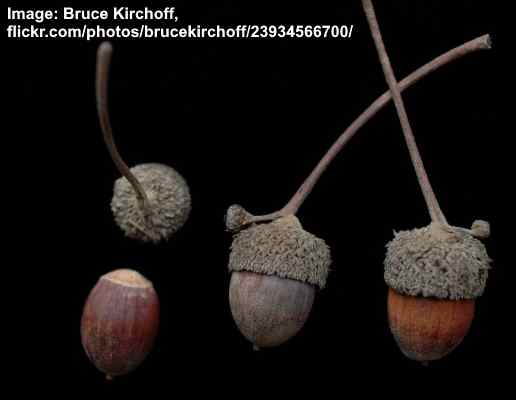
Swamp White Oak Acorns (Quercus bicolor)
The swamp white oak acorn is a small, round nut ranging in color from light brown to dark brown. The edible oval nut sits in a cup-shaped cap that covers up to half of the acorn. These light brown nuts appear in the fall and grow 0.5” to 0.75” (13 – 19 mm).
Swamp white oak acorns are usually found in clusters of two to four nuts on the tree.
Oak tree identification: The swamp white oak tree is identified by its scaly, light gray bark with characteristic vertical furrows. The oak tree leaves measure up to 7” (18 cm) long and have shallow lobes along the elliptical leaves. In the fall, the leaves turn golden yellow, red, copper-brown, or orange before falling.
Chapman Oak Acorn (Quercus chapmanii)
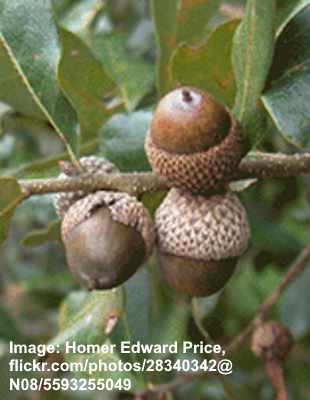
Chapman Oak Acorns (Quercus chapmanii)
Chapman oak acorns are small oval nuts with a light brown shell sitting in a gray scaly cup. The Chapman oak tree produces brown acorns in pairs, which mature in a single season. These brown acorns are identified by their rounded apex and cupule that covers half the nut.
Chapman acorns are from a white oak tree species and grow up to 0.5” (13 mm).
Oak tree identification: The Chapman oak is a native Florida oak tree with thick, shiny, leathery leaves in an obovate shape. The leaves measure 1.5” to 3.5” (38 – 90 mm) long and lack the typical rounded lobes of oak tree leaves.
Bluejack Oak Acorn (Quercus incana)
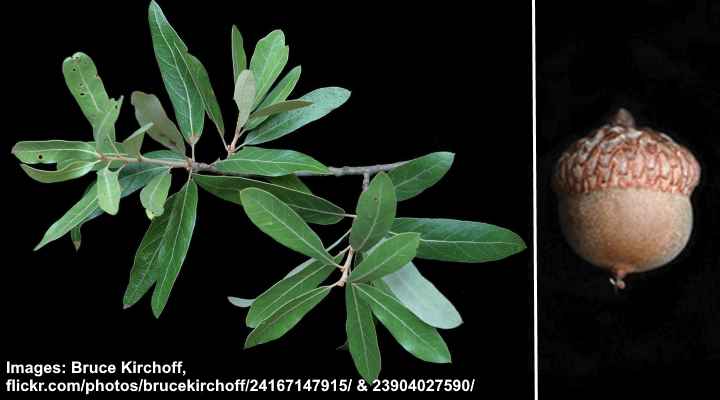
Bluejack Oak Tree (Quercus incana): Leaves and acorn
Also called the cinnamon oak and sandjack oak, the acorns on bluejack oak trees are small, round nuts that mature from green to coppery-brown. Each acorn sits in a cupule covered with reddish-brown scales. These acorns measure 0.5” (13 mm) and mature every second year on the tree.
Oak tree identification: The bluejack oak tree’s identifying features are its glossy, leathery, blue-green leaves, small round light-brown acorns, and dark gray to black furrowed bark with distinctive square plates.
Turkey Oak Acorn (Quercus laevis)
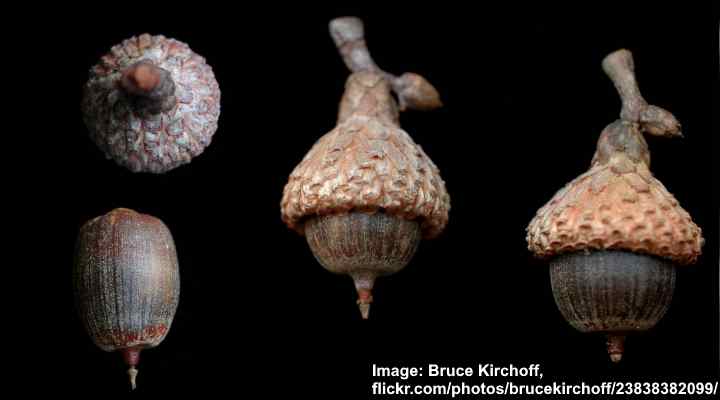
Turkey Oak Acorns (Quercus laevis)
The acorn of the turkey oak tree is a largish dark brown nut sitting in a brown cap that covers up to half of its size. The rounded nut emerges green and has a pointed nib-like apex. Turkey oak tree acorns measure 0.75” to 1” (20 – 25 mm) long.
Oak tree identification: The turkey oak tree is identified as a small oak tree with dark gray bark, irregular vertical furrows, and distinctive three-lobed leaves. The tree’s large acorns are also dark brown and have a cupule of fuzzy scales.
Laurel Oak Acorn (Quercus laurifolia)
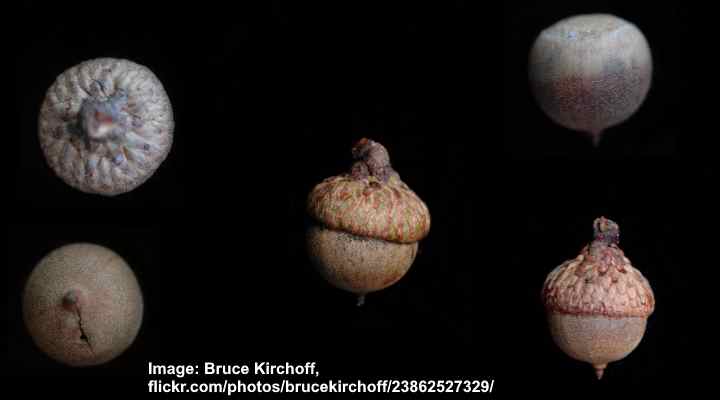
Laurel Oak Acorn (Quercus laurifolia)
The laurel oak tree produces dark brown acorns with faint stripes running from the apex to the base. The brown, almost black acorns sit in a shallow reddish cup that covers about one-third of the nut. Typically, these small oval nuts are 0.5” to 0.66” (13 – 17 mm) long and mature every second year.
The laurel acorn is an important food source for wildlife such as deer, squirrels, turkeys, and birds, who rely on these nuts for sustenance during winter when other food sources are scarce.
Oak tree identification: The laurel oak tree is a semi-evergreen tree with oblong, laurel-like leaves. Other identifying features of the native oak are its dark brown bark, rounded crown, and tolerance to moist, marshy soils.
Overcup Oak Acorn (Quercus lyrata)
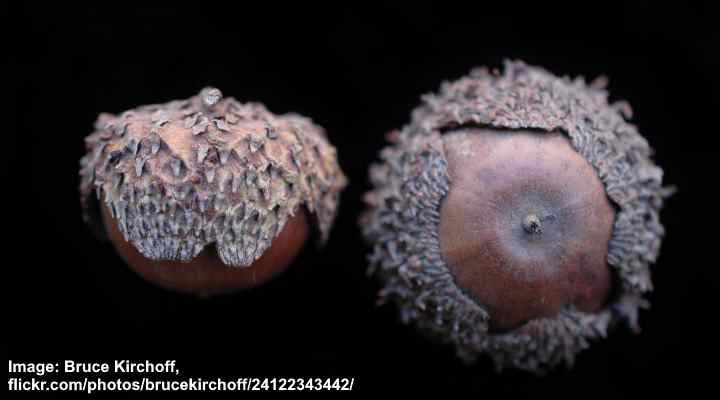
Overcup Oak Acorns (Quercus lyrata)
The overcup oak tree acorn is easy to identify due to its long cap covering the oval to egg-shaped brown nut. The coppery-brown acorn measures 0.5” to 1” (13 – 25 mm) long and has a gray cupule covering two-thirds of the acorn and a slightly fuzzy feel.
Oak tree identification: The overcup oak tree is easily identified thanks to its unique acorns sitting in a large burr-like cap. These oak tree leaves are wedge-shaped with five to nine lobes, dark gray bark, and irregular furrows running vertically.
Swamp Chestnut Oak Acorn (Quercus michauxii)
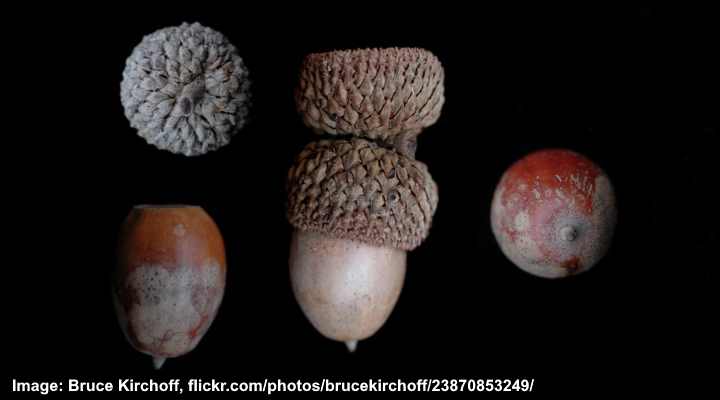
Swamp Chestnut Oak Acorns (Quercus michauxii)
Acorns from the swamp chestnut oak tree are relatively easy to identify. The large brown oval acorns sit in a spiky cupule that is a brown or gray color. A distinguishing feature of swamp chestnut oak acorns is the nut sitting lopsided in the cap. Additionally, these sweet, edible acorns are one of the few varieties you can eat straight off the tree.
Large swamp chestnut oak acorns are large with a unique shape. They measure 1” to 1.5” (25 – 38 mm) long with a gray to brown scaly cap covering one-third to one-half of the nut.
Oak tree identification: The swamp chestnut oak tree is identified by its thin, light-gray peeling bark, revealing an orange-red under bark. Additionally, the acorn tree has ovate leaves with shallow lobes creating wavy margins that measure up to 9” (23 cm) long.
Chestnut Oak Acorn (Quercus montana)

Chestnut Oak Acorns (Quercus montana)
The chestnut oak acorn is a relatively large brown nut with a thin, scaly gray cap covering about one-third of its size. The acorns are reddish-brown and measure 1” to 1.5” (25 – 38 mm) long. Chestnut oak acorns typically grow in pairs but can also be solitary on the tree.
Oak tree identification: The identifying features of the chestnut oak acorn are its dark reddish-brown bark with deep furrows and tight ridges. Also, the oak leaves are lanceolate-shaped with toothed or shallowly lobed margins. They grow 4” to 8” (10 – 20 cm) long.
Myrtle Oak Acorn (Quercus myrtifolia)
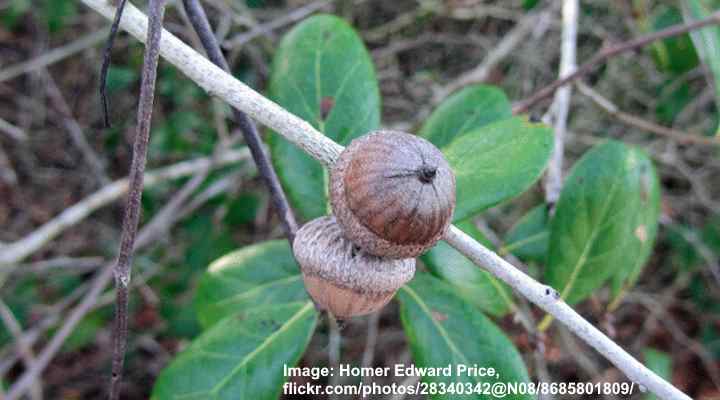
Myrtle Oak Acorns (Quercus myrtifolia)
The myrtle oak tree acorn is a distinctive nut due to its dark brown color and shallow pale brown cap. The egg-shaped acorns sit in a grayish goblet-shaped cap and feature pronounced ridges running from the nib-like apex. The cupule covers one-third to one-quarter of the nut, and the rounded acorn measures 0.62” (16 mm).
Oak tree identification: The myrtle oak tree’s identifying features are dark brown, rounded acorns, obovate evergreen leaves measuring 2” (5 cm) long, and clusters of golden yellow spring flowers.
Water Oak Acorn (Quercus nigra)
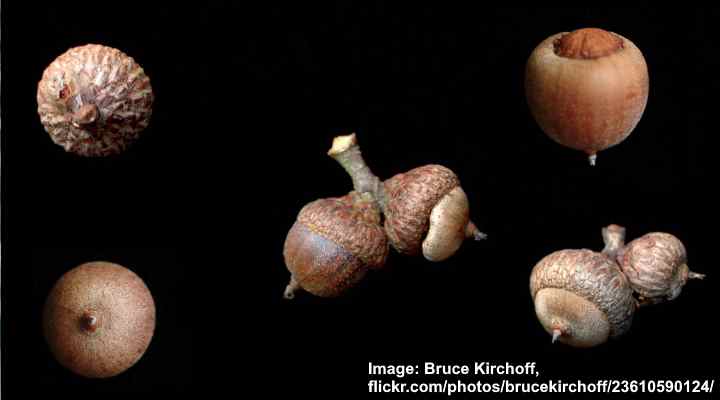
Water Oak Acorns (Quercus nigra)
The water oak tree produces black acorns in woolly, scaly cups. The acorns range in size from 0.5” to 1” (13 – 25 mm), and their flat, scaly caps cover one-third of the nut. Like many species of fast-growing red oak trees, the fruit takes two years to mature, and they have a rich, nutty taste.
Oak tree identification: Native to the southeastern United States, the water oak tree is identified by its brown, smooth bark that becomes gray and furrowed. It also has spatula-shaped leaves with three distinct, bristle-tipped lobes. These oak leaves have a bluish-green upper surface and pale, hairy underside.
Cherrybark Oak Acorn (Quercus pagoda)

Cherrybark Oak Acorns (Quercus pagoda)
Acorns growing on the cherrybark oak tree are identified as small chestnut-brown round nuts sitting in an oversized, bulging cap. The small rounded acorns measure 0.5” (13 mm) and appear wider than tall. The scaly cap covers about one-third of the nut. Like all acorns on species of red oaks, they take two years to mature.
Oak tree identification: The cherrybark oak tree has dark gray bark with prominent scaly ridges, irregular lobes on the large green leaves, and small orange-brown acorns with a hairy, scaly cap.
Dwarf Chestnut Oak Acorn (Quercus prinoides)
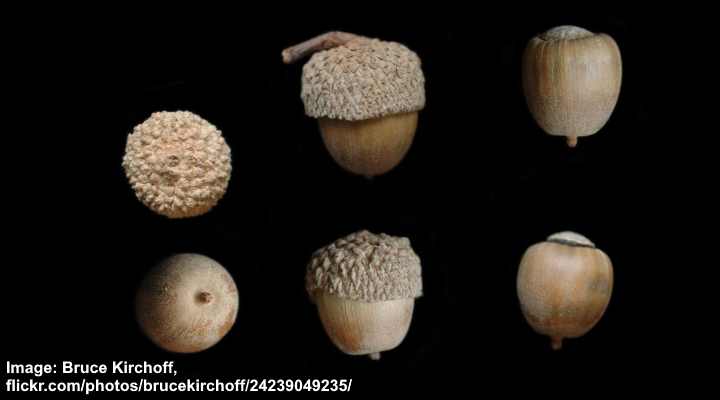
Dwarf Chestnut Oak Acorns (Quercus prinoides)
The dwarf chestnut oak tree acorns are barrel-shaped, tan-colored nuts sitting in a shallow, warty cap. The easily identifiable acorns have a flattened top and develop from a pale brown color to almost black at maturity. The smooth, oval acorn measures 0.5” to 0.75” (13 – 19 mm) tall.
The dwarf chestnut oak tree produces oval to oblong nuts that are light brown. This fast-growing tree produces an excellent harvest of acorns every three to four years. The acorns are easily identified due to their distinct shape and color.
Oak tree identification: Identifying features of the dwarf chestnut oak tree are its yellowish-green lobed leaves with serrated margins. These chestnut-like leaves measure 2” to 5” (5 – 13 cm) long and 1 to 2.5” (2.5 – 6 cm) wide. This small oak tree only grows 12 to 25 ft. (3.6 – 7.6 m) tall and wide.
Sawtooth Oak Acorn (Quercus acutissima)
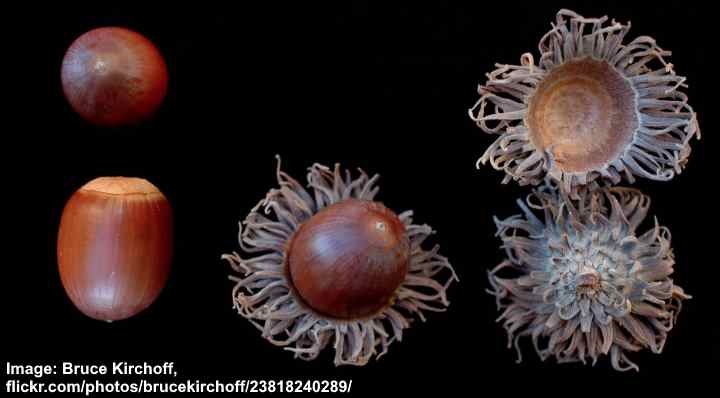
Sawtooth Oak Acorns (Quercus acutissima)
Sawtooth oak tree nuts are some of the most unusual oval brown acorns you will find. The large, dark brown acorns are easy to identify with their distinct smooth appearance and caps with wiry, tentacle-like scales. The oval nut can measure up to 1” (25 mm) long, and the unusual cupules cover two-thirds of the nut.
Oak tree identification: The sawtooth oak tree has a distinctive pyramidal growth habit, lance-shaped green leaves with bristly edges, and abundant brown acorns. The tree’s foliage turns from green to copper-brown in the fall. However, leaves can persist on the tree throughout winter.
Arkansas Oak Acorn (Quercus arkansana)
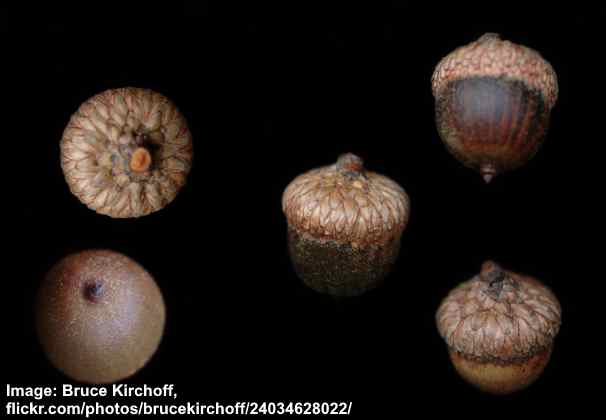
Arkansas Oak Acorns (Quercus arkansana)
The Arkansas oak tree acorn is a dark brown, oval nut with blackish stripes down the side. The small round or egg-shaped nut sits in a tan-colored, goblet-shaped cap that covers one-quarter to one-half of the nut. The dark brown acorns measure 0.62” (16 mm) long.
Oak tree identification: The Arkansas oak tree is a species of red oak tree native to the United States. It’s easy to identify due to distinctive dark-brown oval acorns and spatula-shaped glossy green leaves without any characteristic lobes along the margins.
Nuttall’s Oak Acorn (Quercus texana)
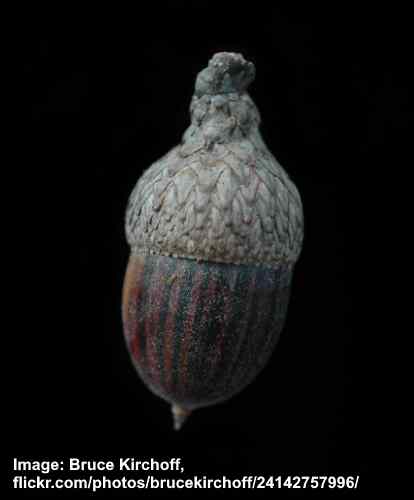
Nuttall’s Oak Acorn (Quercus texana)
Commonly called the Texas red oak, the acorns on Nuttall’s oak tree are egg-shaped with a pointed apex and black stripes down the side. The large, chestnut-brown nuts measure 0.75” to 1” (19 – 25 mm) tall and have thin, scaly caps covering one-half and one-third of the brown acorn.
The acorns mature in two years on this species of red oak.
Oak tree identification: Nuttall’s oak tree is identified by its relatively smooth dark brown or gray bark, large leaves with bristle-tipped lobes, and dark brown oval acorns.
Blackjack Oak Acorn (Quercus marilandica)
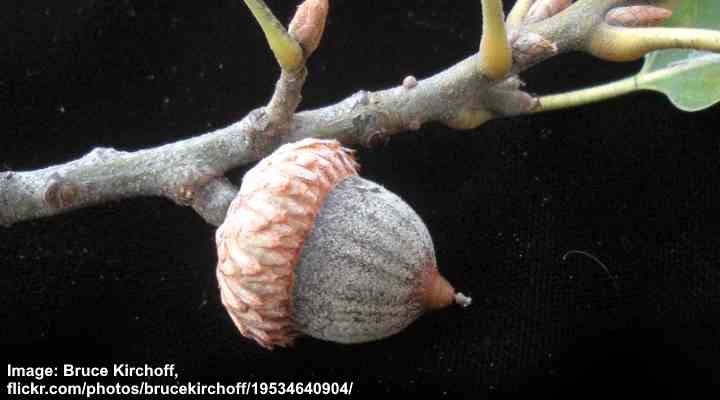
Blackjack Oak Acorn (Quercus marilandica)
Acorns on the blackjack oak tree are relatively small and sit in wide, shallow scaly caps. These acorns emerge greenish-brown and turn dark brown with a whitish coating. Additionally, the pointed acorns have noticeable stripes down their sides. Blackjack oak tree acorns measure 0.75” (19 mm) long.
Oak tree identification: The identifying features of the blackjack oak tree are its dark gray bark that looks like alligator skin, shiny green leaves with five bristle-tipped lobes, and small dark brown acorns.
Swamp Post Oak Acorn (Quercus similis)
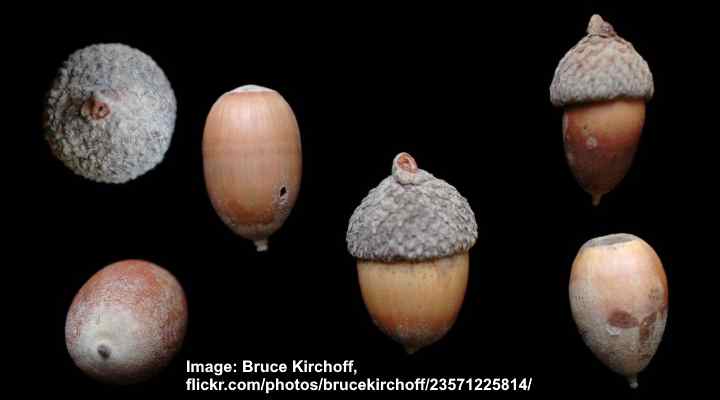
Swamp Post Oak Acorns (Quercus similis)
Swamp post oak tree acorns are oval, slender egg-shaped brown nuts with a pointed apex. These oak tree nuts have a unique appearance, with a smooth, light-brown appearance and the brown acorns sitting in a grayish cap covering one-half of the nut. These ovoid to barrel-shaped acorns measure up to 0.75” (19 mm) long.
Oak tree identification: The swamp post oak tree is identified by its flaky brown bark, egg-shaped leaves with three pairs of shallow lobes, and light brown acorns with distinctive powdery bumps on the cap.
Dwarf Live Oak Acorn (Quercus minima)
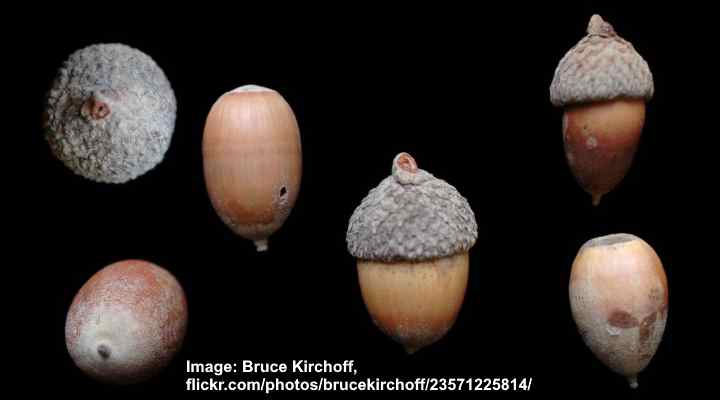
Dwarf Live Oak Acorns (Quercus minima)
The dwarf live oak is a shrub-like oak tree producing distinctive elongated oval pale brown nuts. The small acorns emerge dark green and turn pale or dark brown as they mature. An unusual feature of this dwarf oak shrub is that the acorns grow upright from the branches.
Dwarf live oak acorns grow 0.5” to 1” (13 – 25 mm) long and up to 0.5” (13 mm) wide. They also sit in a vase-shaped gray scaly cap.
Oak tree identification: The dwarf live oak tree is identified by its glossy light to dark green lanceolate leaves, measuring 4.5” (12 cm) long. The small evergreen oak shrub grows 6.5 ft. (2 m) tall and has smooth, brown to light gray bark.
Boynton’s Sand Post Oak Acorn (Quercus boyntonii)
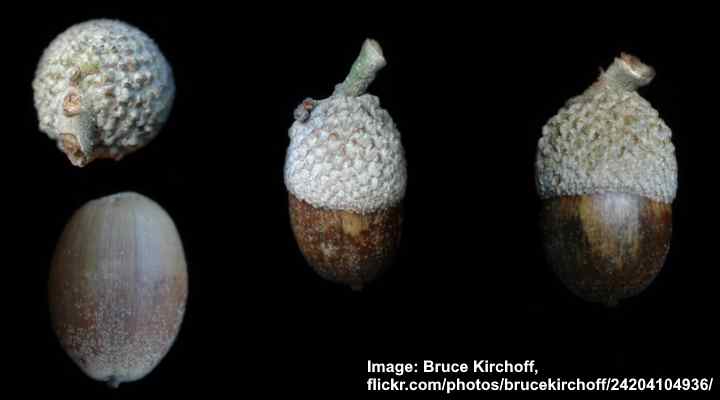
Boynton’s Sand Post Oak Acorns (Quercus boyntonii)
The acorns growing on the Boynton’s sand post oak are small brown nuts in a gray warty cap. Identifying features of the acorns are the ovoid shape with a rounded apex. Additionally, the acorns have a light to dark brown color and measure 0.62” (16 mm) long.
Oak tree identification: The Boynton’s sand post oak is a dwarf semi-evergreen or deciduous shrub, identified by its obovate leaves measuring 4” (10 cm) long, brown scaly bark, and height of around 6.5 ft. (2 m).
Northern Pin Oak Acorn (Quercus ellipsoidalis)
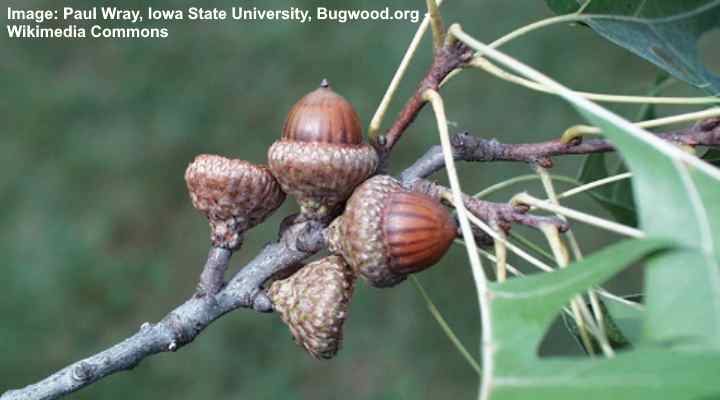
Northern Pin Oak Acorns (Quercus ellipsoidalis)
Also called jack oak or hill’s oak, the northern pin oak is a type of red oak tree with stumpy, rounded acorns sitting in saucer-shaped cups. The brown acorns have noticeable stripes from the pointed apex to the base. In addition, the light brown nuts measure 0.75” (19 mm) long, with the cap covering up to one-half of the nut.
Oak tree identification: The northern pin oak tree has glossy green leaves with five to seven several bristle-tipped lobes, rounded, narrow acorns, and dark brown scaly bark. The large oak grows 50 to 70 ft. (15 – 21 m) tall.
Sand Live Oak Acorn (Quercus Geminata)
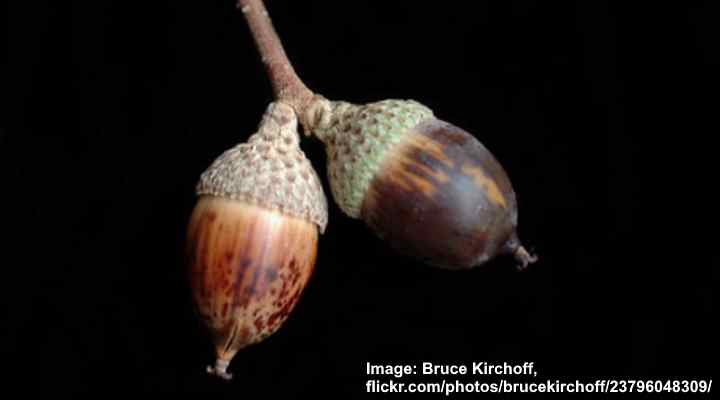
Sand Live Oak Acorns (Quercus Geminata)
Acorns growing on the evergreen sand live oak tree are large, egg-shaped nuts that measure around 1” (25 mm) long. The nut, with its distinctive pointed apex, has a dark brown appearance and sits in a whitish-gray scaly cupule. Typically this shrub-like oak tree produces acorns in clusters of one to three.
Oak tree identification: The sand live oak tree is identified by its thick, leathery, dark green leaves, dark brown to black deeply furrowed bark, and abundant egg-shaped, dark brown acorns
How to Harvest Acorns
The best time to harvest acorns is in fall, just after they have fallen from the oak tree. To find the tastiest acorns, look for larger nuts with smaller caps. These generally have less amounts of tannins. After collecting them, dry them indoors to prevent them from going moldy.
Always discard acorns with small holes as these are signs of weevil activity. Also, throw away any acorns with green seeds.
How to Process Acorns
Process acorns for consumption by leaching the tannins. To leach the tannins from acorns soak and rinse the raw acorns in cold water until the water runs clear. The leaching process may take several days, depending on how long it takes for all the tannins to leach out of the acorn meat. Next, remove the shells. However, you may find shelling acorns easier by letting them dry out. After shelling them, remove the dark skins from the acorn seeds as these contain bitter tannins.
To prevent the acorn nuts from oxidizing, place them in cold water. After that, you are ready to use them to make acorn flour.
A more straightforward way to enjoy acorns is to roast them in the oven at 350°F (180°C) for 60 minutes. However, it would still be best to leech them to remove the tannins.
Learn about the many types of oak trees and how to identify them (pictures included).
Related articles:
